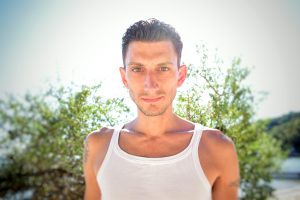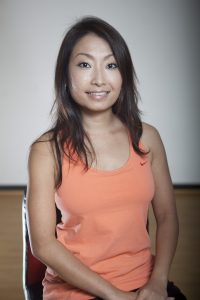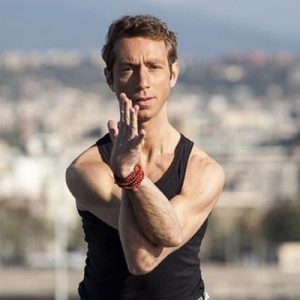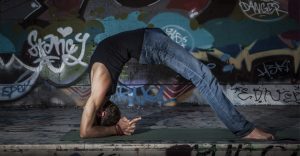Yoga Theatre – play your life” By Francesco Zinnamosca and Jessica Ugatti
Sito web: www.yogatheatre.com E-mail: info@yogatheatre.com
Instagram: @yogatheatre Facebook Page: Yoga Theatre – Play your life @yogatheatre.yogatheater
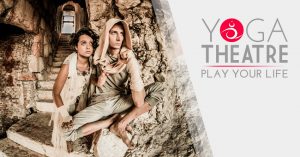
In this times of chaos by rediscovering our true nature we can help the World change, starting from ourselves
It’s time to come out of the closet and live life to the fullest.
How many limitations do we discover and recognize practicing on the mat which are really hard to overcome in daily life?
How often is our communication and expression turn out not to be as we would love them to be?
How often do we feel judged and limited? How can we believe in our intuitions and potentiality?
There are so many things we can struggle with during our yoga practice and there are so many mind tendencies that appear when we meditate.
Everything we recognize on the mat could be a step forward to get in touch with our best self. But how to use this observations to create a stable change and remain centered in our daily lives?
Theatre, as a metaphor of life, gives us a valid aid to get rid of the boundaries dictated by our mind beliefs. It improves our communication and creative skills helping us contacting our true nature and free expression.
Infact, when we identify ourselves with our own tendencies we become a character, forgetting who we truly are and living our role without enjoying it.
The fusion of Francesco Zinnamosca and Jessica Ugatti’s researches has given birth to a method created to experience practically and concretely many of those mechanisms that interfere with the evolution process, rediscovery and self-knowledge.
From the urge of helping others understand in a simple and straight way how to live a lighter life without fear and anxiety is born “Yoga Theatre – play your life”, which merges the yoga philosophy and practice of Odaka Yoga® with acting techniques and actor training giving useful tools to support, deepen or complete artistic, personal or spiritual studies.
Before stepping on stage, the actor training allows to set the human being free from unwieldy layers collected throughout the every-day behavior, facilitating an open and genuine expression and providing fundamental instruments to thoroughly understand the creative process.
We can find an interesting link in the ancient Indian text Natya Shastra which tells us the origin and purpose of performance arts.
The myth says that in the days of yore people became addicted to sensual pleasure, under the sway of desire and greed, they became infatuated with jealousy and anger and found their happiness mixed with sorrow.
So the Gods asked Brahman for a diversion and he created a fifth Veda which could conduce to duty and wealth and give guidance to the people of the future as well in all their actions through theatre, dance and music.
Furthermore, the spiritual path of yoga, through the observation of the mind-body dialog, helps understand our true nature and be aware of the infinite possibilities we have to experience life for a fluid and graceful state of living.
Ancient mystics’ journey is for everyone and “Yoga Theatre – play your life” translates it for the modern times creating a bridge between two complementary arts that have always been devoted to ennoble the human spirit.
The World, as a huge stage, sees us as actors of the greatest play: life!
About the founders
Jessica Ugatti
Her acting experience started at the age of four and, from then, theatre has always been her travel mate, making her feel alive, free and fearless. Graduated at the National Academy of Dramatic Art Silvio d’Amico in Rome, she is Acting Master, actress, performer, pedagogue and Odaka Yoga® teacher. Right after the academic studies she has debuted on both small and big screen, working with renowned Italian and international actors and directors. At the same time she has started teaching acting applied to different disciplines and age ranges. Live performance and improvisation have always played a central role in her artistic evolution and in the understanding of the use of different expressive languages. After having deepened her studies in several fields such as character development, comedy and clown, she has given birth to her most beloved character, Vibrissa: a multifaceted host, singer and one-woman show artist.
As a funambulist-like dreamer she bounces from stage to reality devoting her life to the research of the tools we all need to facilitate free expression for a happier life. Along with Francesco, she’s undertaken a marvellous journey discovering spirituality and yoga. Swinging from the ostensible fiction of theatre to the path of truth and deepening the understanding of her inner abilities, she has committed to the creation of Yoga Theatre. Thanks to her sri-lankan origin she has grown up surrounded by rituality and sense of community. She has always loved to valorize the capabilities of every person and believed in team work as a means to create a reality based on integration to exploit the human potential and its multiforme expression to a fuller extent. She is co-founder of the “Fools” theatre company, a platform dedicated to exploration and theatrical innovation and founder and art director of Burlesque & Cabaret Verona and Vibrissa Academy of Performing Arts, projects which promotes individual improvement through theatre teaching applied to performance art.
“Yoga helps me in the research and discovering of life with endless passion. Theatre reminds me that even as a “grown up” it is possible to continue playing and living every experience with curiosity and wonder.”
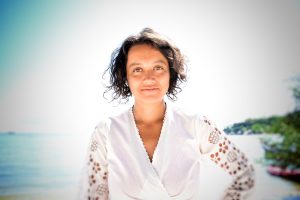
Francesco Zinnamosca
Yogi and Odaka Yoga® teacher, he has always been fascinated by eastern philosophy and the several facets of the human mind. In the practice of yoga he’s found a path of personal growth which helps him comprehend how the abilities acquired during his life could be used to serve others’ evolution and spiritual development.
His family’s research brought him to his first trip to India at the age of twelve to Swami Sai Baba. From the vision of Integral Yoga of Sri Swami Satchidananda and from Kadampa buddhism, he has and still receives excellent teachings on how to accept and overcome daily difficulties through a deeper comprehension of the basic life dynamics. In 2004 he has met Jessica Ugatti, who has been his life partner since, who introduced him to the world of theatre by which he remained truly fascinated. He has cooperated with the Fools theatre company and various productions as Opera tech director, light designer, stage director, scenographer and actor. Founder, manager and tech director of Burlesque & Cabaret Verona and Vibrissa Academy of Performing Arts, he has produced and organized shows and big events since 2012. These experiences allowed him to develop tech and creative resourcefulness and to learn how to use his communication, teaching and acting skills in a more conscious way. He has worked as head bartender and manager in hospitality for more than fifteen years within Verona, Rome, London and Brisbane (Australia). These experiences have given him the chance to get in contact with different customs and traditions and learn the art of adaptability which have helped him keep a free and open mind.
“Past experiences help me keep an open vision over the World and remain curious about events in life. Yoga helps me everyday use my abilities in the best way possible for a shared growth.”
